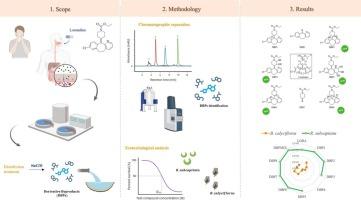氯雷他定的次氯化:衍生副产物的化学鉴定和生态毒理学效应。
IF 8
1区 环境科学与生态学
Q1 ENVIRONMENTAL SCIENCES
引用次数: 0
摘要
氯雷他定(LORA)是自1993年获FDA批准以来广泛使用的第二代抗组胺药。LORA的大量排泄(约40%在尿液中,42%在粪便中)导致其经常出现在废水中,随后出现在水生环境中,其中通常以纳克/升的水平检测到。本研究探讨了LORA降解副产物(DBP)在中性低氯化(一种常见的水消毒过程)下的可能形成。通过高效液相色谱分离得到8个DBPs,并通过核磁共振(NMR)和质谱(MS)对其进行了充分的表征。其中5个化合物为首次报道。提出了所有已鉴定的dbp的形成途径。采用生态毒理学方法对不同营养水平的淡水物种(主要生产者Raphidocelis subcapitata)和主要消费者轮虫Brachionus calyciflorus)的急性和慢性毒性进行了评价。DBPs在浓度为数百μg/L时发生急性效应。在慢性毒性方面,藻类对LORA及其衍生物均表现出较低的敏感性,而轮虫对DBPs更敏感,有效浓度范围从几ng/L到数百ng/L。相反,LORA在2000 ng/L时仅诱导38%的效应,表明与母体化合物相比,DBPs的慢性毒性更高。这些结果强调了LORA DBPs的环境相关性,它可能比母体化合物对水生生物造成更高的慢性风险,特别是在典型的水处理条件下。本文章由计算机程序翻译,如有差异,请以英文原文为准。

Hypochlorination of Loratadine: Chemical identification and ecotoxicological effects of derivative byproducts
Loratadine (LORA) is a second-generation antihistamine widely used since its approval by the FDA in 1993. The significant excretion of LORA (approximately 40 % in urine and 42 % in feces) contributes to its frequent occurrence in wastewaters and subsequently in aquatic environments, where it is typically detected at ng/L levels. This study investigates the possible formation of LORA degradation byproducts (DBP) under neutral hypochlorination, a common water disinfection process. Eight DBPs were generated, and they were isolated via HPLC and fully characterized by nuclear magnetic resonance (NMR) and mass spectrometry (MS). Among them, 5 compounds have been reported here for the first time. Formation pathways were proposed for all identified DBPs.
The acute and chronic toxicity of LORA and its DBPs was evaluated using ecotoxicological assays with freshwater species representing different trophic levels: the microalga Raphidocelis subcapitata (primary producer) and the rotifer Brachionus calyciflorus (primary consumer).
Acute effects of the DBPs occurred at concentrations of hundreds of μg/L. Regarding chronic toxicity, algae showed low sensitivity to both LORA and its derivatives, while rotifers were more susceptible to the DBPs, with effective concentrations ranging from a few ng/L to hundreds of ng/L range.
Conversely, LORA induced only a 38 % effect at 2000 ng/L, indicating higher chronic toxicity of DBPs compared to the parent compound.
These results underscore the environmental relevance of LORA DBPs, which may pose a higher chronic risk to aquatic organisms than the parent compound, especially under typical water treatment conditions.
求助全文
通过发布文献求助,成功后即可免费获取论文全文。
去求助
来源期刊

Science of the Total Environment
环境科学-环境科学
CiteScore
17.60
自引率
10.20%
发文量
8726
审稿时长
2.4 months
期刊介绍:
The Science of the Total Environment is an international journal dedicated to scientific research on the environment and its interaction with humanity. It covers a wide range of disciplines and seeks to publish innovative, hypothesis-driven, and impactful research that explores the entire environment, including the atmosphere, lithosphere, hydrosphere, biosphere, and anthroposphere.
The journal's updated Aims & Scope emphasizes the importance of interdisciplinary environmental research with broad impact. Priority is given to studies that advance fundamental understanding and explore the interconnectedness of multiple environmental spheres. Field studies are preferred, while laboratory experiments must demonstrate significant methodological advancements or mechanistic insights with direct relevance to the environment.
 求助内容:
求助内容: 应助结果提醒方式:
应助结果提醒方式:


